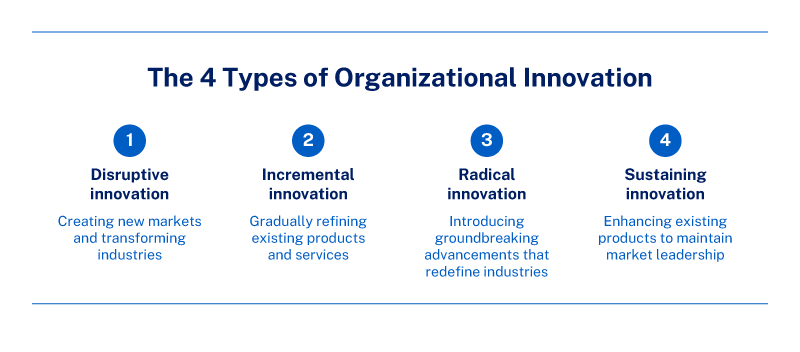Your organization’s innovation strategy can determine whether you thrive or fall behind. Effective innovation management transforms promising ideas into tangible results that drive growth. Meanwhile, companies without clear innovation efforts often struggle to maintain relevance as markets evolve around them.
The four types of innovation – disruptive, incremental, architectural, and radical – each offer distinct pathways to solving business challenges and gaining competitive advantage. Understanding these approaches will help you develop targeted solutions to your most pressing problems.
This article explores how different innovation types address specific business challenges and provides a framework for developing a comprehensive innovation strategy that drives sustainable growth.
- The 4 types of organizational innovation
- What is business innovation, and why does it matter?
- How to develop an effective innovation strategy for your organization?
- Build your innovation capabilities
What is business innovation, and why does it matter?
Business innovation means implementing new ideas that create value beyond the status quo. This can transform creative concepts into practical solutions that enhance operations, products, or customer experiences.
So, now that you understand what business innovation is, why does it matter? Here are some examples of how business innovation can impact key business areas:
Expanding and diversifying revenue streams
Innovation creates new revenue opportunities by enhancing existing product lines or developing entirely new offerings. Apple demonstrates this by consistently introducing new product categories – from the iPod to the Apple Watch – while simultaneously improving its core offerings.
Apple’s shift toward services revenue shows how innovation extends beyond hardware. The company’s App Store, Apple Music, and iCloud services now generate billions in recurring revenue, transforming its business model from purely transactional to increasingly subscription-based.
Increasing competitive market presence
Strategic innovation helps companies capture a larger market share by standing out in crowded markets. Tesla, for example, grew its share of the car market by improving everything from how it builds cars to how customers buy them.
The company makes its own batteries and charging stations, giving it an advantage that older car companies couldn’t quickly copy. This approach lets Tesla sell expensive cars to luxury buyers despite being new to the industry.
Tesla’s direct-to-consumer sales model also lets customers order custom vehicles online and pick them up at Tesla stores, reinventing the traditional car-buying experience.
Improving efficiency and reducing costs
Process innovations lead to advancements in productivity while optimizing resource allocation. Amazon’s implementation of robotics in fulfillment centers exemplifies how operational innovation can dramatically reduce costs while increasing speed and accuracy.
The company’s automated systems now handle everything from inventory management to package sorting – tasks that once required extensive manual labor.
These efficiencies translate to competitive advantages through faster delivery times, lower prices, and improved quality – all factors that influence customer purchasing decisions.
Enhancing customer experience and loyalty
Innovation directly enhances customer satisfaction by addressing unmet needs and improving product functionality.
A forward-thinking hotel chain, for instance, might revolutionize the guest experience by creating a mobile app that not only handles check-in but also serves as a digital room key, controls room temperature, and orders room service – all addressing pain points in the traditional hotel experience and increasing customer engagement.
Collecting user feedback and analyzing customer journey maps are innovations that can help organizations identify frustration points and develop targeted solutions that strengthen loyalty and increase lifetime customer value.
Another example of business innovation enhancing customer experience comes from Absa Group. Through a partnership with IMD, Absa redesigned its leadership development to support a digital-first, pan-African brand transformation – strengthening internal capabilities while deepening relevance with customers across diverse markets.
Strengthening data-driven decision-making
Data-driven innovations provide better insights for strategic planning and tactical execution.
Netflix’s recommendation algorithm represents how analytics can transform decision-making processes across an organization. The streaming giant analyzes millions of subscribers’ viewing patterns to predict what content will keep viewers engaged, which directly informs both content acquisition and original production decisions worth billions of dollars.
This helps executives allocate resources effectively and adapt quickly to changing viewer preferences.
Another example of how business innovation strengthens decision-making comes from OCP Group. IMD partnered with Africa Business School to co-create a custom program that helped OCP align talent development with strategic priorities, enabling participants to generate data-backed solutions and explore new growth opportunities.
The 4 types of organizational innovation
Understanding the different types of innovation will help you develop targeted strategies for organizational growth and market differentiation:

1. Disruptive innovation: creating new markets and transforming industries
Disruptive innovation creates new markets by offering alternatives that eventually displace established products and services. Business theorist Clayton Christensen first described this concept, noting how simpler, more affordable solutions can transform industries by appealing to overlooked customer segments.
Startups frequently leverage disruptive innovation to challenge market leaders, as they’re not constrained by existing business models or customer expectations. This approach often begins with serving niche markets before expanding to capture mainstream customers.
Netflix is a prime example of disruptive innovation, having transformed how people consume entertainment. Beginning as a mail-order DVD rental service competing with Blockbuster, Netflix evolved its innovation framework to embrace streaming technology.
By developing a subscription model for unlimited streaming, Netflix created an entirely new market for on-demand entertainment. This approach eventually rendered traditional video rental businesses obsolete while establishing Netflix as a market leader in streaming content.
2. Incremental innovation: gradually refining existing products and services
Incremental innovation involves making continuous improvements to existing technologies, products, or processes. Rather than completely reinventing offerings, companies gradually enhance their functionality, efficiency, or design to better serve customer needs.
This approach typically requires lower investment and carries less risk than other innovation types, making it accessible to organizations of all sizes. The cumulative effect of small improvements often leads to significant competitive advantages over time.
Toyota is a strong example of incremental innovation. The company has consistently refined iterations of its manufacturing processes through its famed Toyota Production System, introducing small but impactful changes that improve quality, reduce waste, and increase efficiency. These continuous enhancements have helped Toyota maintain its reputation for reliability and operational excellence over decades.
3. Radical innovation: introducing groundbreaking advancements that redefine industries
Radical innovation creates entirely new products, services, or technologies that fundamentally change industries. Unlike incremental approaches, radical innovation represents a complete departure from existing solutions rather than gradual improvement.
This innovation type typically emerges from extensive research and development efforts. It offers substantial first-mover advantages but carries higher risks due to technological uncertainty and market adoption challenges.
Smartphones are an example of radical innovation that created new opportunities across multiple industries. By combining telephone, internet, and computing capabilities, this groundbreaking technology redefined how people communicate and access information, resulting in today’s ubiquitous iPhones and other popular devices like those produced by Android and Samsung.
4. Sustaining innovation: enhancing existing products to maintain market leadership
Sustaining innovation improves and refines existing products, services, or business models to maintain leadership positions in established markets. This approach focuses on optimizing functionality and addressing evolving customer needs within current business frameworks.
Unlike disruptive innovation, sustaining innovation strengthens market position through continuous improvement rather than market creation. These innovation efforts typically align closely with existing customer bases and revenue streams.
Microsoft Office exemplifies sustaining innovation through its ongoing evolution. The productivity suite has maintained market share for decades by continually enhancing functionality to meet changing customer needs.
Transitioning from standalone software to cloud-based subscription services changed Microsoft’s business model while improving their products’ accessibility. The company’s decision-making process balanced preserving familiar elements with introducing new capabilities, maintaining customer satisfaction through thoughtful evolution rather than radical reinvention.
How to develop an effective innovation strategy for your organization?
Successful innovation strategies integrate multiple innovation types to address different business challenges. A structured approach aligns innovation efforts with broader organizational goals while fostering creativity.
An innovation framework is a roadmap that guides how your company approaches different forms of innovation. This structure helps prioritize initiatives based on strategic objectives, available resources, and market opportunities, and includes several key steps:
- Engage external collaborators: Use open innovation to bring in fresh ideas from outside your company. Set up a platform where partners, startups, or researchers can propose solutions to specific challenges.
- Involve key stakeholders early: Include customers, partners, and employees in the innovation process to ensure relevance and increase buy-in. Hold regular feedback sessions to review prototypes and gather input before full-scale rollout.
- Establish clear development processes: Create structured workflows – such as a stage-gate system – to evaluate progress, assign accountability, and ensure only viable innovations move forward.
- Foster a supportive culture: Encourage teams to experiment by normalizing failure and learning. Highlight lessons from both wins and setbacks through recognition programs that reinforce a culture of continuous improvement.
Companies like 3M demonstrate how structured innovation frameworks drive success. Its “15% time” gives employees the freedom to spend up to 15% of their paid working hours on passion projects of their choice – even if those projects fall outside their immediate job responsibilities. The key is that these efforts must still align with 3M’s broader strategic goals.
This approach encourages bottom-up innovation by trusting employees to identify opportunities and experiment without excessive oversight. Many of 3M’s most successful products – including the Post-it Note – originated from this policy.
Build your innovation capabilities
The different types of innovation – disruptive, incremental, radical, and sustaining – are powerful tools for addressing unique business challenges. Each approach offers distinct advantages, from creating entirely new markets to optimizing existing products to better meet customer needs.
Successful companies develop balanced innovation portfolios that include various approaches. This diversification helps organizations pursue breakthrough business model innovations while simultaneously refining current offerings through sustaining innovation. Strategically investing in new products and technologies while continuously improving solutions in existing markets can position companies for long-term growth.
To develop your organization’s innovation capabilities and drive meaningful results, consider enrolling in “Driving Strategic Innovation.” This collaborative program from IMD and MIT Sloan equips business leaders with practical tools for implementing different types of innovation – from disruptive breakthroughs to incremental improvements.
Participants explore business model opportunities, value chain design, and talent management through an end-to-end roadmap. The immersive experience helps leaders influence corporate culture, improve stakeholder relationships, and create sustainable competitive advantages in increasingly unpredictable markets.
IMD’s innovation programs help leaders build the mindset and skills to drive innovation across their organization – not just in R&D, but in strategy, operations, and culture. Through practical tools, peer collaboration, and expert guidance, participants learn how to embed innovation into everyday decision-making. Whether you’re shaping strategy or leading teams, these programs empower you to create lasting impact and stay ahead of industry shifts.
Stay up to date 💌
Join the IMD Community.
Stay informed with our latest insights on leadership, strategy, digital transformation and more. Explore fresh perspectives from IMD business school to help you navigate today’s complex business landscape.




